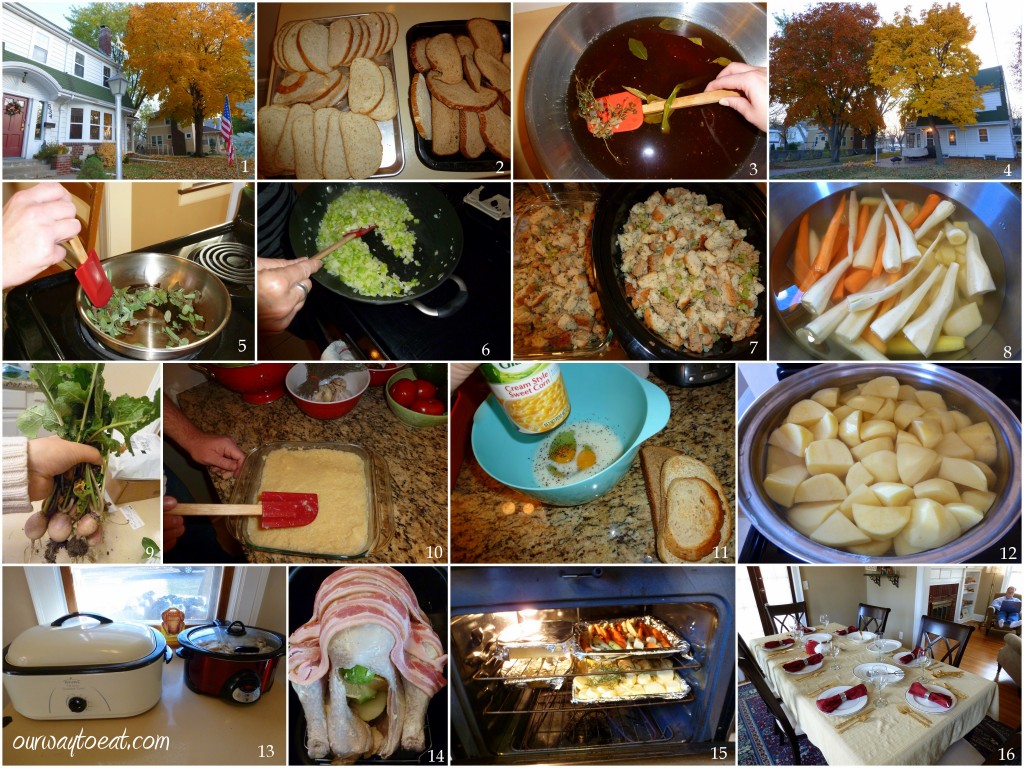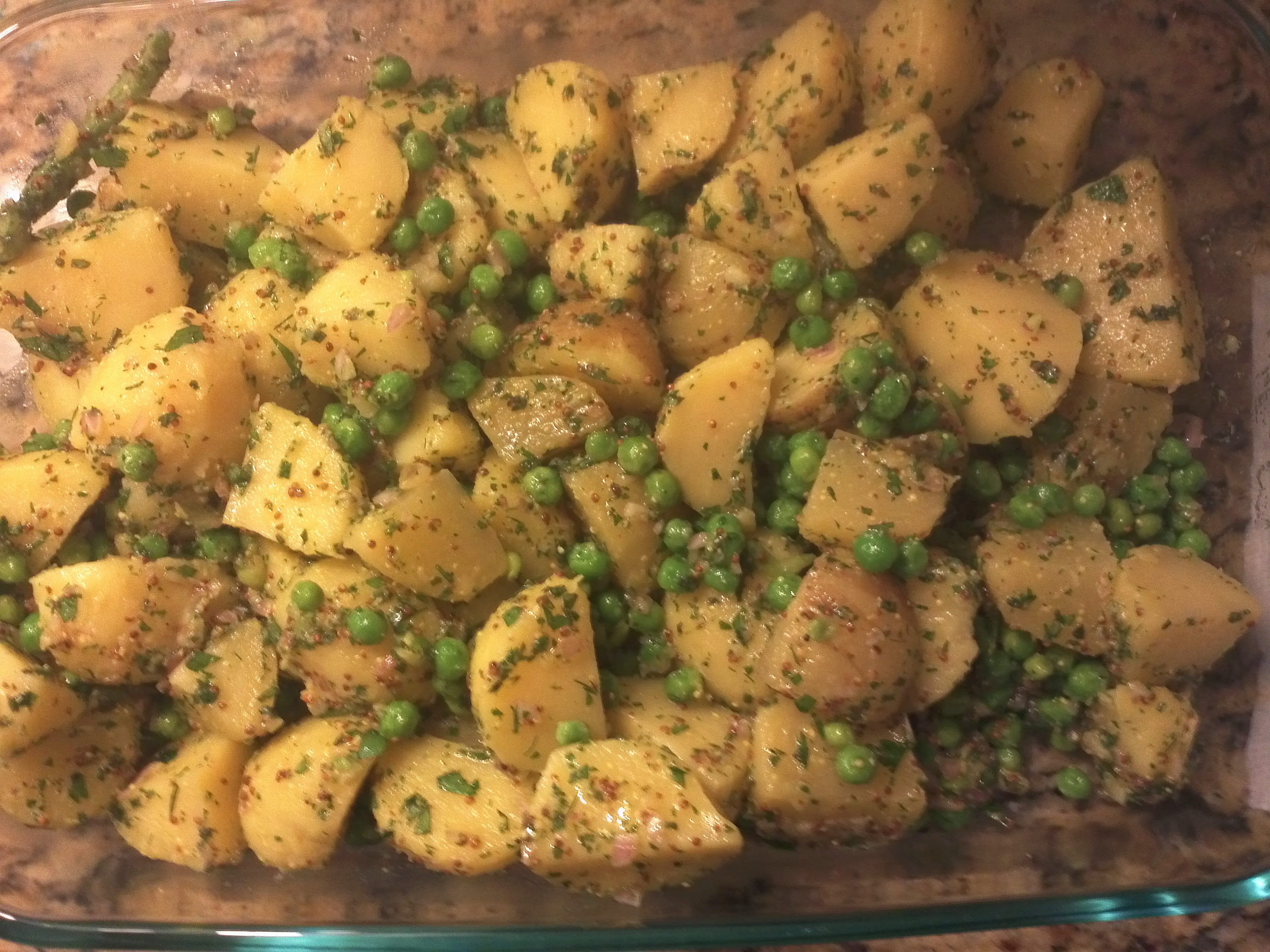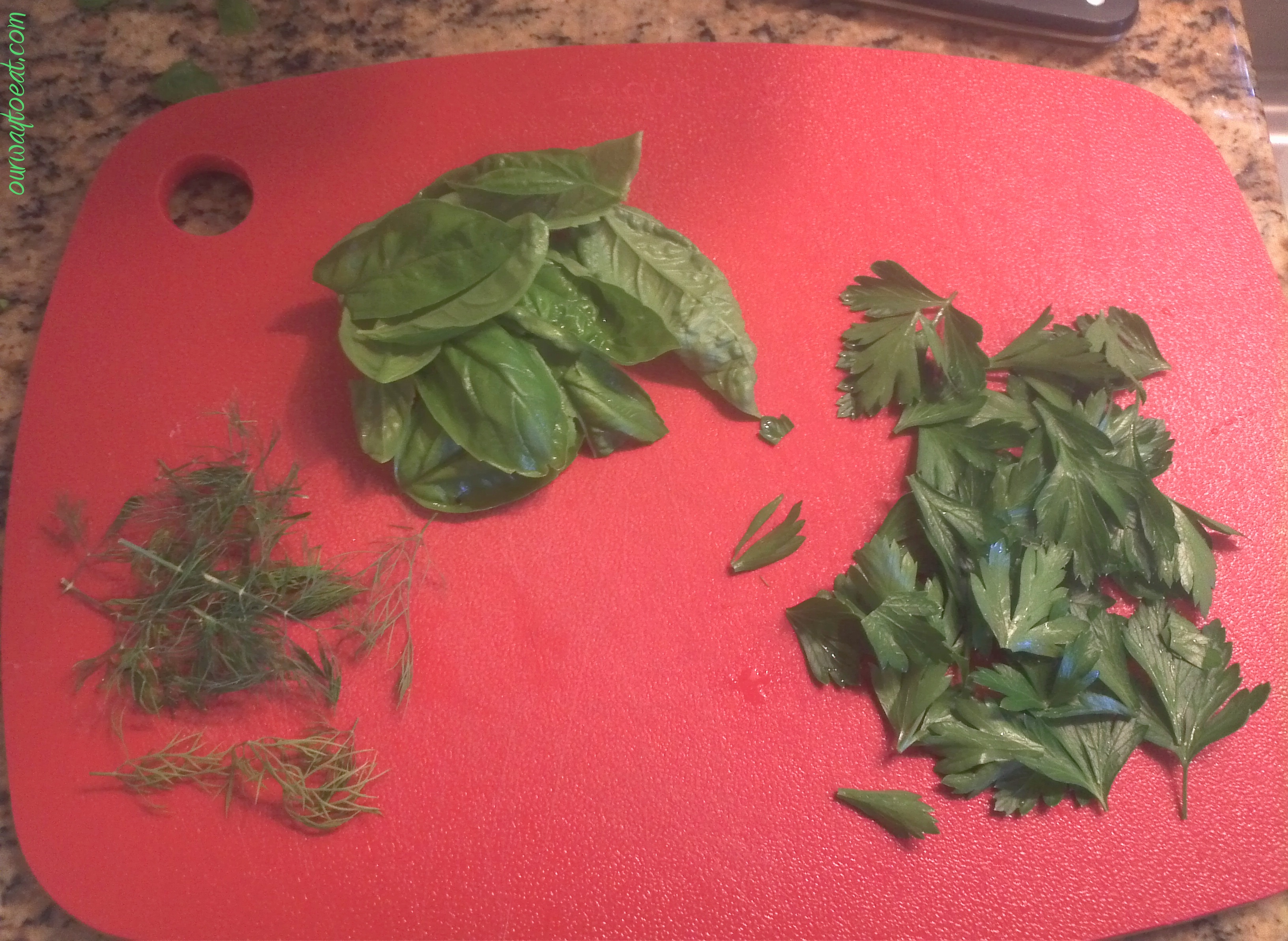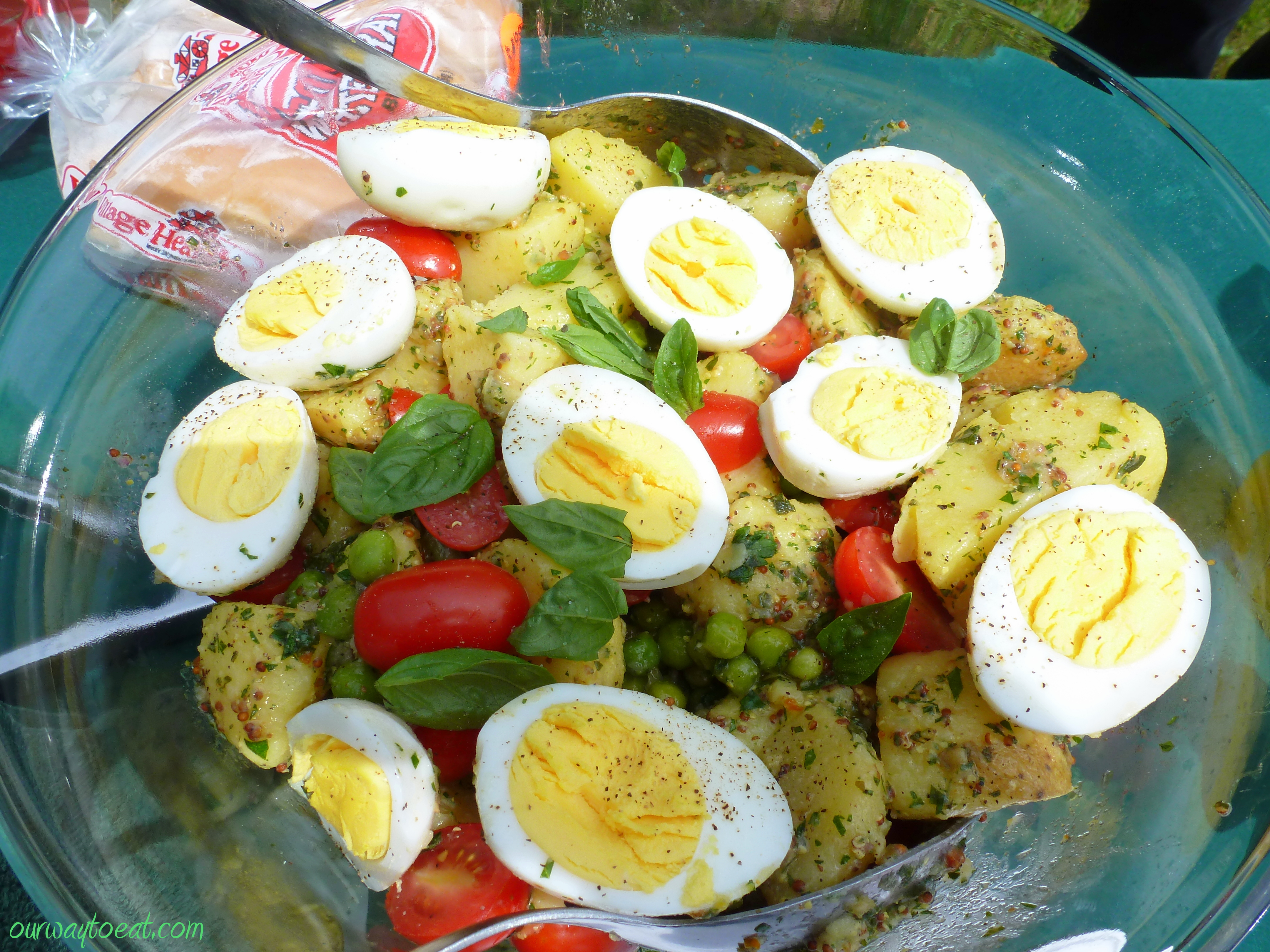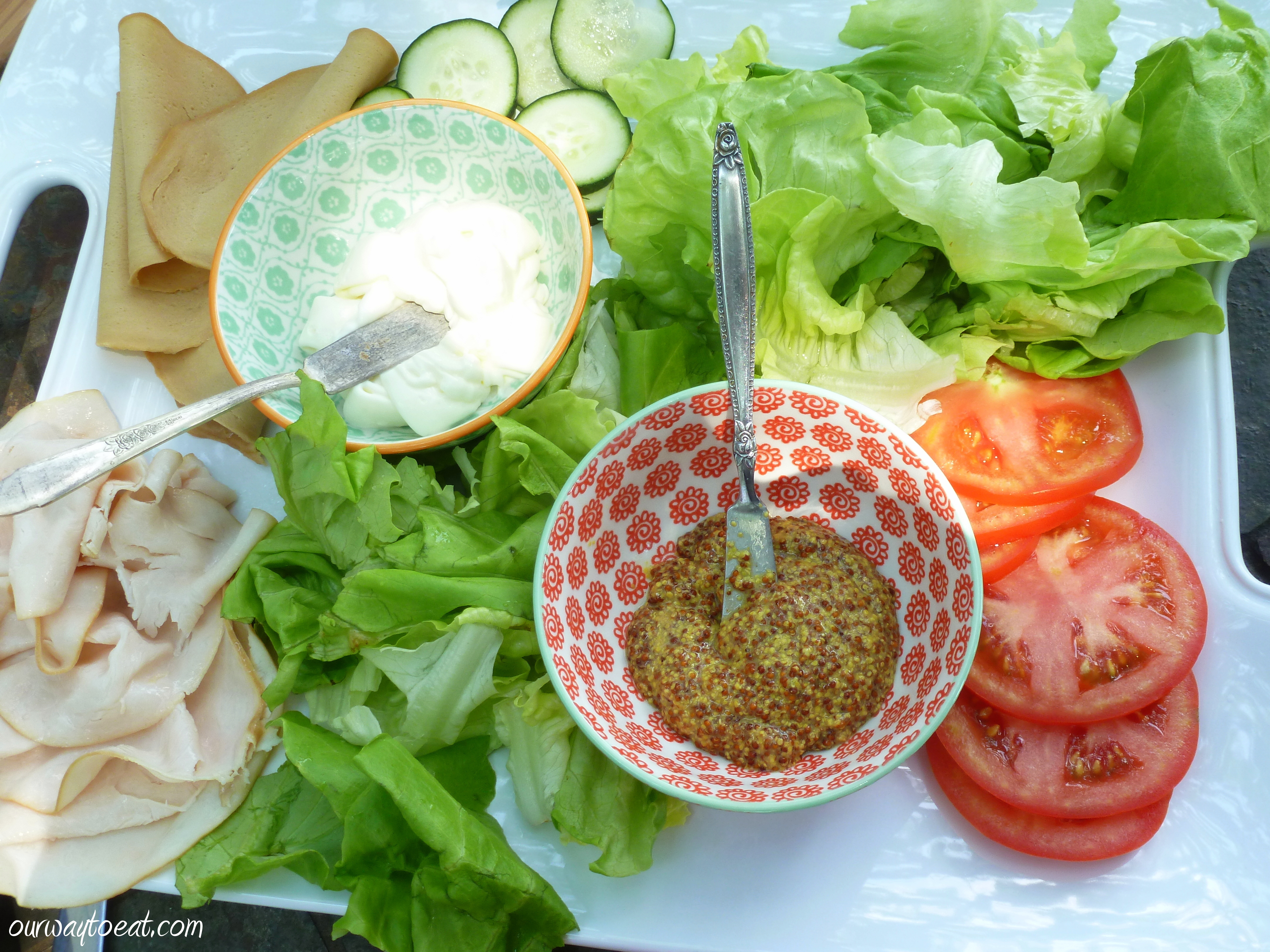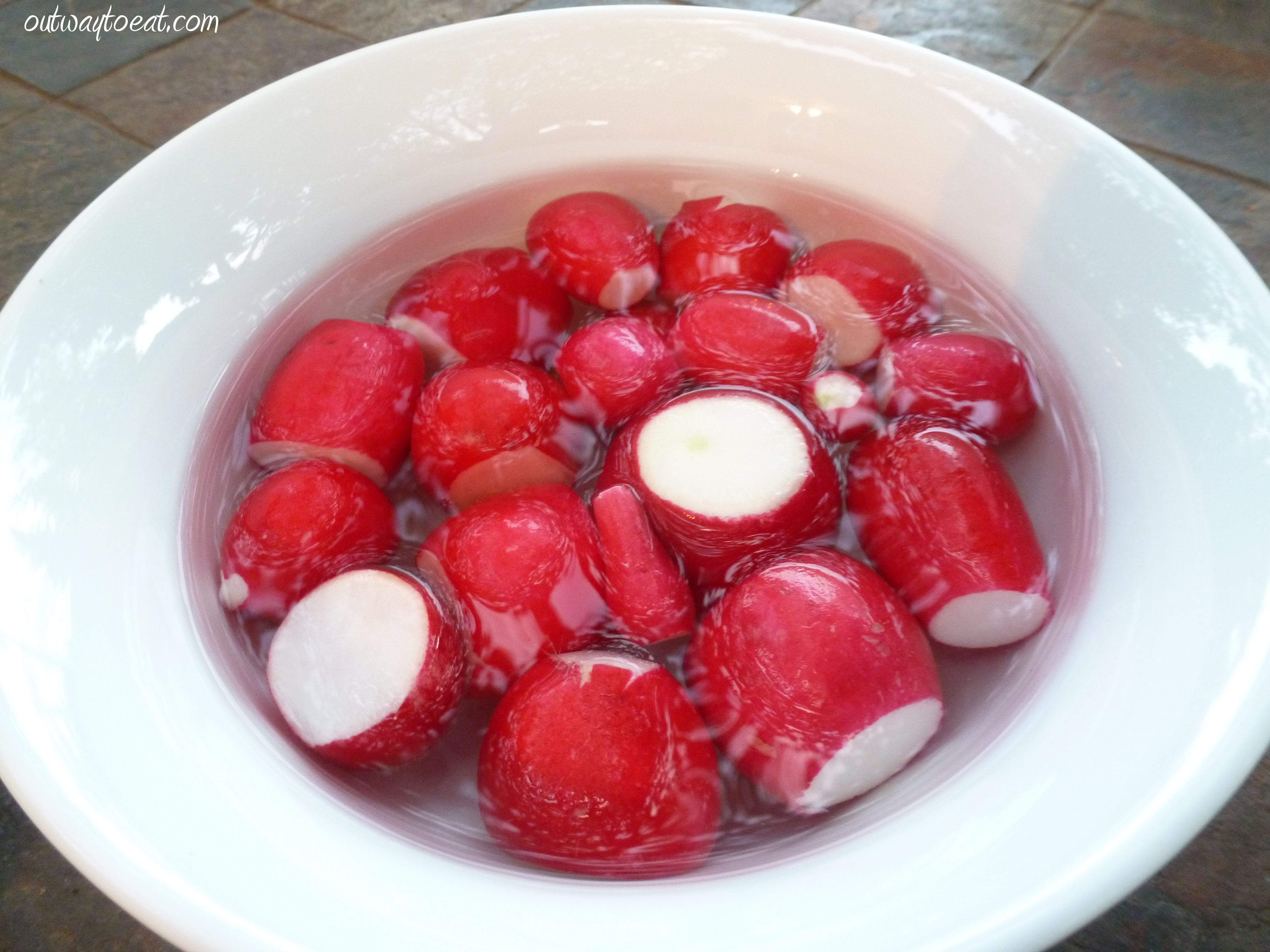I don’t know about everyone else, but for me, whenever my in laws are visiting, I tend to have an above average number of kitchen mishaps.  Take for example, the day a kitchen shelf “leapt” from the wall. It smashed my precious mortar and pestle received as a gift from Bjorn as well as a jar of balsamic reduction which spattered most of the kitchen with a thin layer of sticky brown goo. There were also those blueberry muffins that turned out like hockey pucks the day I invited Val for breakfast a few years back. Most recently, I attempted to make deviled eggs out of some lovely, fresh, farmer’s market eggs, and –the eggs would not peel. When the world hands you eggs that are locally grown, fresh, organic and lovely that —will not peel– make Disheveled Eggs! Disheveled Eggs start by following your favorite approach to making Deviled Eggs, mine being a stiff, simple egg yolk mixture with a little mayo, minced celery or shallot, salt, pepper and a bit of mustard to taste. The key to Disheveled Eggs is to pile on eye-catching, creative and tasty garnishes to disguise and distract from your less-than-perfect peeling and filling of the egg halves. Among my great garnish ideas either used or imagined are thinly sliced radishes, finely chopped chives, sprigs of dill and parsley, thinly sliced baby dill pickles, a tiny spoonful of capers, some flaky tuna or a little smoked salmon, a tiny bubble-tower of salty of caviar, a squirt of Sriracha “Rooster Sauce,” tiny olives, a heavy shake of smoked paprika, or a tiny pile of thinly sliced prosciutto. No matter how much you are sweating it in the kitchen, if you bring this platter of fancifully garnished eggs to table you will receive reactions of awe and delight–trust me. My quick-fix to classic deviled eggs was inspired by James Beard Award winning Canal House Cooks Every Day cookbook by Melissa Hamilton & Christopher Hirsheimer not only did this lovely tome inspire many of my imaginative garnishes, but they finally gave me instructions to cook eggs from soft to medium to hard with reliable results. For the ambitious who prefer to follow a recipe, here is a deviled egg recipe using homemade mayo piped into the egg halves recently posted on Amateur Gourmet. Bon Appetit!
Take for example, the day a kitchen shelf “leapt” from the wall. It smashed my precious mortar and pestle received as a gift from Bjorn as well as a jar of balsamic reduction which spattered most of the kitchen with a thin layer of sticky brown goo. There were also those blueberry muffins that turned out like hockey pucks the day I invited Val for breakfast a few years back. Most recently, I attempted to make deviled eggs out of some lovely, fresh, farmer’s market eggs, and –the eggs would not peel. When the world hands you eggs that are locally grown, fresh, organic and lovely that —will not peel– make Disheveled Eggs! Disheveled Eggs start by following your favorite approach to making Deviled Eggs, mine being a stiff, simple egg yolk mixture with a little mayo, minced celery or shallot, salt, pepper and a bit of mustard to taste. The key to Disheveled Eggs is to pile on eye-catching, creative and tasty garnishes to disguise and distract from your less-than-perfect peeling and filling of the egg halves. Among my great garnish ideas either used or imagined are thinly sliced radishes, finely chopped chives, sprigs of dill and parsley, thinly sliced baby dill pickles, a tiny spoonful of capers, some flaky tuna or a little smoked salmon, a tiny bubble-tower of salty of caviar, a squirt of Sriracha “Rooster Sauce,” tiny olives, a heavy shake of smoked paprika, or a tiny pile of thinly sliced prosciutto. No matter how much you are sweating it in the kitchen, if you bring this platter of fancifully garnished eggs to table you will receive reactions of awe and delight–trust me. My quick-fix to classic deviled eggs was inspired by James Beard Award winning Canal House Cooks Every Day cookbook by Melissa Hamilton & Christopher Hirsheimer not only did this lovely tome inspire many of my imaginative garnishes, but they finally gave me instructions to cook eggs from soft to medium to hard with reliable results. For the ambitious who prefer to follow a recipe, here is a deviled egg recipe using homemade mayo piped into the egg halves recently posted on Amateur Gourmet. Bon Appetit!
Category Archives: Farmer’s Market
Fresh Tomato Pasta for the Height of Tomato Season
Every time I come upon a tomato grown in our garden, I exclaim, “hello, gorgeous!”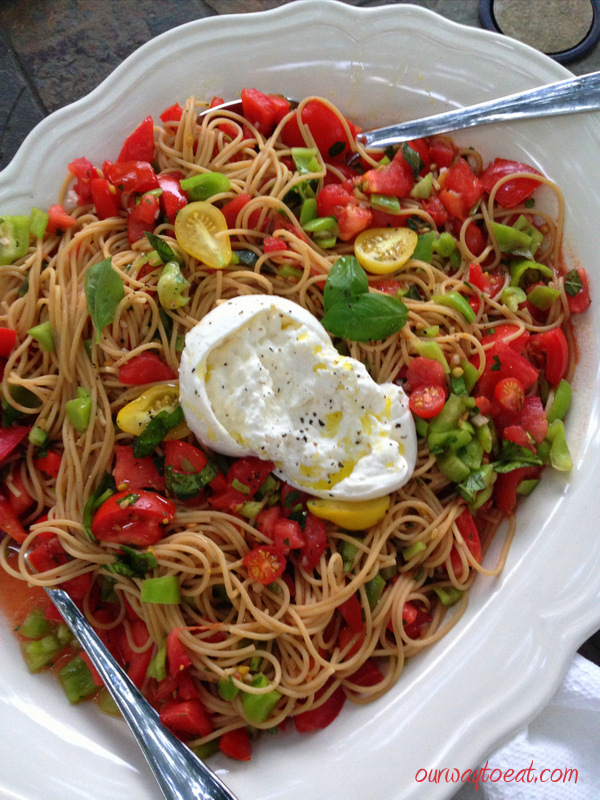
My garden and the farmer’s market are booming juicy ripe tomatoes. We have been enjoying tomatoes with reckless abandon with simple preparation: in BLT’s, in a caprese salad or sliced on their own. Another delicious and simple preparation that honors a juicy tomato is this uncooked tomato pasta sauce that I tossed with hot whole grain spaghetti. It contained sliced and chopped tomatoes, two chopped sweet Italian peppers, a clove of garlic- minced, chopped flat leaf parsley, basil, and a few dashes of red wine vinegar and the tiniest drizzle of olive oil. I mixed up the sauce and left it raw, then tossed it with the pasta, cooked al dente. I topped it with fresh cracked pepper, a little salt and a ball of Buratta: fresh mozzarella with a creamy center, opened for scooping a spoonful on to each plate. The Burrata is a nice texture compromise between ricotta and regular fresh mozzarella and really made this lush. This was a fabulous summer pasta and an easy way to focus entire meal on tomatoes, raw and in their finest form: juicy and warm from the vine. Summer’s lease hath too short a date! Dig in! My recipe is a mash-up of recipes from Martha Stewart (here and here) and from a recipe from Bon Appetit, with the addition of Burrata from my own imagination.
After a break from blogging over the summer, I’ve decided to make shorter posts more the norm. I’ll be interested to hear what you think.
Thanksgiving Preview
Thanksgiving is only a few days away. I am looking forward to it! It will be our third year hosting my parents, in-laws and brother-in-law at our house. Thanksgiving traditions have varied and evolved throughout my life from being celebrated in October (in Canada) to having a large gathering at my parents house or Bjorn’s Aunt and Uncle’s to a smaller gathering at our house. This has become one of my favorite long weekends of the year being with both of our families, eating well, relaxing and having lots of laughs. Here is a peek at last year’s Thanksgiving preparation and the resulting meal. It is also a reliable preview of this year’s anticipated event. There will some tweaks to the menu to keep things interesting, but we’ll serve our most-loved standbys to make sure everyone get their favorite traditional Turkey Day dish.
1. Our home from the front, framed by a gorgeous golden-leafed maple tree. This year all of our leaves have fallen and have been raked and hauled away. We’ve become much more zen about raking and hauling leaves this year. It is a huge job, but we’re used to it, and we enjoy being outside in the fresh air and we love these gorgeous maples so much. It sure is nice to have a cleaned up yard before snowfall this year.
2. City Bread, drying out for stuffing. City Bread is my favorite rye bread from Winnipeg which made the bulk of our stuffing last year. We’re due to visit the ‘Peg, our freezer is empty!
3. Last year I brined the Turkey using this recipe from Macheesmo. Everyone reported the bird to be juicy and flavorful and despite concerns, I was pleased that I could still make a tasty gravy using the drippings. This year I am not brining the bird. Bjorn is brining a bone-in turkey breast that he will smoke, so I’m skipping that step since my roast turkey will play second fiddle. I wouldn’t roast a turkey, but we simply must so that we can make gravy!
4. Our little house from the back, again the maple leaves last year were gorgeous. This year, with the leaves down the focal point of this view of our house is the new roof, which is cottage red. I love it, but I’m waiting for some finishing work to be done in front before I post pictures.
5. Toasting sage from the garden for my Mosaic Stuffing. I call my dressing Mosaic Stuffing because I clean out my freezer and use up the random loaves, rolls and bread ends that I’ve been hoarding in the freezer for the last few months. I love using a variety of bread with different flavors and textures as a basis for my dressing. I follow my Mom’s dressing recipe which comes together on the spot with her coaching. It is a simple recipe with bread, butter, sautéed onions, celery, salt, pepper, sage, broth and milk, similar to the recipe from the 1967 edition of the Betty Crocker cookbook but with some extra love and instinct as to seasonings, amount of milk and cooking time. We like it crispy on top and moist in the middle.
6. Sauteing celery and onions in butter for the stuffing.
7. Two pans of stuffing, one for today, and the next for the equally important Leftovers Meal, eaten tomorrow.
8. We round out our plates with a variety of roasted root vegetables: carrots, parsnip, and beets, coated lightly in olive oil and tossed with a generous handful of chopped fresh herbs.
9. Last year I grew one square foot of turnips which we saved for Thanksgiving.
10. Bjorn made the turnips into a Turnip Puff. It was a tasty vegetarian side dish, though it isn’t on the menu this year since we didn’t grow turnips!
11. Scalloped Corn is another Thanksgiving standby which will be repeated this year, except this year I am going to add more whole corn kernels as well as creamed corn and bake it in a cast-iron skillet.
12. We make a huge pot of creamy, buttery mashed potatoes because everyone loves them. I was very disappointed by the potato selection last year at Lunds– by the time I got there to shop, so many of the potatoes were green. This year I bought a bushel basket of Yukon golds from the Saint Paul Farmer’s Market. There isn’t exactly a crowd shopping at the market this late in the season, so I had my pick of potatoes and the friendly seller assured me they had just been dug and wouldn’t be green by Thursday. Shrinking the carbon footprint of our meal where I can, and having my selection of freshly dug potatoes is win-win in my book.
13. It is an all-hands-on-deck meal situation at our house. I haul out the roaster, use the crock pot and have every precious square inch of kitchen counter and table space in use to prepare this meal.
14. In contrast to the last two years, I bought a turkey from Lunds instead of from the Farmer’s Market this year. I haven’t had a lot of success buying a local turkey. I stood in line for two hours in 2010 to pick up a monstrous golden turkey, and could hardly thaw myself or get the bird cooked in time to eat the next day. Last year, our pre-ordered “fresh” local turkey was frozen and missing a wing. I’m willing to pay for quality locally grown meat, but when I’m paying a premium, I need to be assured that quality will be delivered. This year, I wanted a smaller bird and so I went the easy route. Yes, I do feel a bit guilty for not buying totally local when I can, but I decided to give myself a break. I am much happier with a completely fresh, free range bird which weighs about 12 pounds. I will be stuffing the bird with herbs and fruit, and covering it with butter and bacon, which is a family tradition, passed down from my Grammie.
Grammie roasting a huge turkey topped with bacon. Look at that Golden Bird!
15. Even though I used an electric roaster and crock pot, the oven was packed. I’m planning fewer dishes this year so we should have oven space to spare.
16. We will set the table using our Mikasa Cameo Platinum wedding china. It is simple and clean-looking, and I love it. This year, we have the full set including gravy boat! I am going to warm up the table decor a little bit this year, more candles, more colour, though the plated food will remain the focal point.
The Thanksgiving Meal:
1. Get a load of that plate of food! You will note that we enjoy both traditional cranberry sauce made by my mother-in-law, and jellied from a can. We also are so very fortunate that my mother-in-law and Bjorn’s Grandma make lefse together. My Dad and Grandfather were born in Norway, but they moved to Canada without packing their traditional Norwegian recipes, so I am pretty pleased to have married into a family in which the lefse-making tradition is going strong. I have had a lesson from Bjorn’s Grandma, and I will share that some time.
2. Mashed potatoes topped with chopped chives. I dried tons of herbs from our garden which I will use in Thanksgiving dishes and throughout the winter. This is a meal where I splurge on fresh herbs, though hopefully never again after this year, since I’m planning to plant a little indoor herb garden soon. They make everything look great and they add wonderful flavor and color that I love to see on our Thanksgiving table.
3. “Don’t drown your food” was a catchphrase from educational children’s public television. That message sunk deep into my brain. This is the one time of year I ignore it. To me, pumpkin pie is only to be served with a mighty dollop of sweetened, freshly whipped cream.
4. What is my key to a stress-free Thanksgiving? Say “yes” when people offer to bring things, especially things you aren’t good at making. I have never in all my born days baked a pie. If we’re lucky, maybe I never will. Thanks Mom!
5. The table looks festive once it is covered in an array of platters topped with appealing, sumptuous Thanksgiving standards. We’re ready to dig in!
6. Another impressive plate of food, this one topped with the brined, roasted turkey. You can see the lovely roasted golden beets on the right of the plate. They will be making an appearance again at our Thanksgiving table this year.
7. My immediate family, from left to right, my Mom, mother-in-law; brother-in-law, Dad, father-in-law and my darling Bjorn.
8. Another view of the table, close enough to see the roast turkey, carved and arranged by Bjorn, and a gorgeous platter of carrots and parsnip covered in herbs.
9. We have a buffet in our dining room which holds the dinner-table overflow. Here, wine bottles are ready to top-up our glasses, dressing stays warm in the crock, and scalloped corn and turnip puff are ready to be devoured.
10. My Mom’s homemade pumpkin pie. Pumpkin pie for Thanksgiving is a homey tradition we can’t do without and her pie hits the spot.
11. The men all managed to nod off for a well-timed nap right after the meal was over. I have to wonder if tryptophan is the cause, or if they’re employing well-timed dish-washing avoidance strategy?!
12. Later in the day we manage some how to get hungry again. We set a less formal table with sandwich fixings and haul out the turkey platter.
13. We round out the turkey sandwich meal with salty snacks and cookies that my Mom and Val bring. We’ll have a full-fledged Leftovers Meal tomorrow.
We have so much to be thankful for and we are so truly grateful, wishing you and yours a wonderful Thanksgiving week.
Chef Shack Food Truck at the Mill City Farmer’s Market in Minneapolis
 We visit the Saint Paul Farmer’s Market every weekend that we’re in town. We had friends visiting from out of town last weekend, and so we decided to change up the routine and venture out to the Mill City Farmer’s Market to check out a different market and sample a much-buzzed Twin Cities Food Truck that parks there on Saturday mornings. We weren’t surprised to find that the Mill City Farmer’s Market is a great place for crowd watching, beautiful produce and good eats.
We visit the Saint Paul Farmer’s Market every weekend that we’re in town. We had friends visiting from out of town last weekend, and so we decided to change up the routine and venture out to the Mill City Farmer’s Market to check out a different market and sample a much-buzzed Twin Cities Food Truck that parks there on Saturday mornings. We weren’t surprised to find that the Mill City Farmer’s Market is a great place for crowd watching, beautiful produce and good eats.
 The Mill City Farmer’s Market is tucked between the Guthrie Theater, the Mill City Museum, and the Gold Medal Flour elevator and the condominium building that houses Spoonriver, my favorite restaurant in Minneapolis. The Mill District and nearby Saint Anthony Main, which is directly across the wonderful pedestrian-only Stone Arch Bridge over the Mississippi are two of the most fun pockets of Minneapolis to stroll through. I love their lively atmosphere and unique architecture which reflect the area’s evolution over time from a riverfront industrial district to the cultural center of the city. Even though I love visiting these places, this was our first trip the Mill City Farmer’s Market. Although the vegetable stands were overflowing with organic veggies, it is much more than just a place to stock up on heirloom tomatoes. People gather, music is played, there are artisanal cheeses, chocolate and baked goods, handmade clothing, furniture and other art for sale. The space was packed to the gills by mid-morning with strollers, camera-wielding bloggers, Iphone-ing instagrammers, gawkers, some shoppers and people like us who are there to eat.
The Mill City Farmer’s Market is tucked between the Guthrie Theater, the Mill City Museum, and the Gold Medal Flour elevator and the condominium building that houses Spoonriver, my favorite restaurant in Minneapolis. The Mill District and nearby Saint Anthony Main, which is directly across the wonderful pedestrian-only Stone Arch Bridge over the Mississippi are two of the most fun pockets of Minneapolis to stroll through. I love their lively atmosphere and unique architecture which reflect the area’s evolution over time from a riverfront industrial district to the cultural center of the city. Even though I love visiting these places, this was our first trip the Mill City Farmer’s Market. Although the vegetable stands were overflowing with organic veggies, it is much more than just a place to stock up on heirloom tomatoes. People gather, music is played, there are artisanal cheeses, chocolate and baked goods, handmade clothing, furniture and other art for sale. The space was packed to the gills by mid-morning with strollers, camera-wielding bloggers, Iphone-ing instagrammers, gawkers, some shoppers and people like us who are there to eat.
 Once we toured the market, we joined the lengthy line at the Chef Shack food truck. The line moved quickly. It gave us just enough time to peruse the chalkboard menu. Bjorn ordered a Walleye Sandwich and a bag of the Chef Shack’s renowned Indian-Spiced Mini Doughnuts for the group to share for dessert. As you can see, the sandwich consists of a meaty walleye fillet, fried crispy and served on a fresh baguette with lettuce, tartar sauce and veggie trimmings. Bjorn confirmed that the sandwich was one of the best he’s had. The four of us devoured the mini doughnuts so fast that I couldn’t even take a picture.
Once we toured the market, we joined the lengthy line at the Chef Shack food truck. The line moved quickly. It gave us just enough time to peruse the chalkboard menu. Bjorn ordered a Walleye Sandwich and a bag of the Chef Shack’s renowned Indian-Spiced Mini Doughnuts for the group to share for dessert. As you can see, the sandwich consists of a meaty walleye fillet, fried crispy and served on a fresh baguette with lettuce, tartar sauce and veggie trimmings. Bjorn confirmed that the sandwich was one of the best he’s had. The four of us devoured the mini doughnuts so fast that I couldn’t even take a picture.
Our friend Ben was out for adventure. When he placed his order for Beef Tongue Tacos, the guy handling the cash register told him that he eats a Beef Tongue Taco every week he loves them so much. The meat eaters who sampled the tongue confirmed that it was a dense, beef flavor and texture, more offal-like than muscle-y. There! You can see the tongue poking out from below the corn! The vegetarian in me says “eek!” and the foodie says “cool!”
I swung by the Spoonriver food stand and purchased a refreshing glass of unsweetened Mango Iced Tea. Their Cucumber Water and Watermelon-Basil water were also beautiful and looked refreshing. It was very tempting to try a savory Spoonriver crepe, but I wanted to stick to the Food Truck option for today.
I was the sole vegetarian in the group. I ordered the Sweet Potato Tacos, one of several vegetarian offerings from the Chef Shack. They were tasty. I piled on some of the house-made garnishes available in tubs: pickly cukes and cauliflower, a dill pickle and some slaw. I am a sucker for garnishes. The double-layered tortillas were extremely fresh and delicious. I was glad to have the second tortilla layer, because the bean-corn-sweet potato mixture in the tacos was on the watery side, though wonderfully flavorful. The tortilla kept it all contained. I crumbled a little fresh feta from Singing Hills Dairy, purchased in the market on top–I won’t lie, I do prefer veggie tacos with cheese.
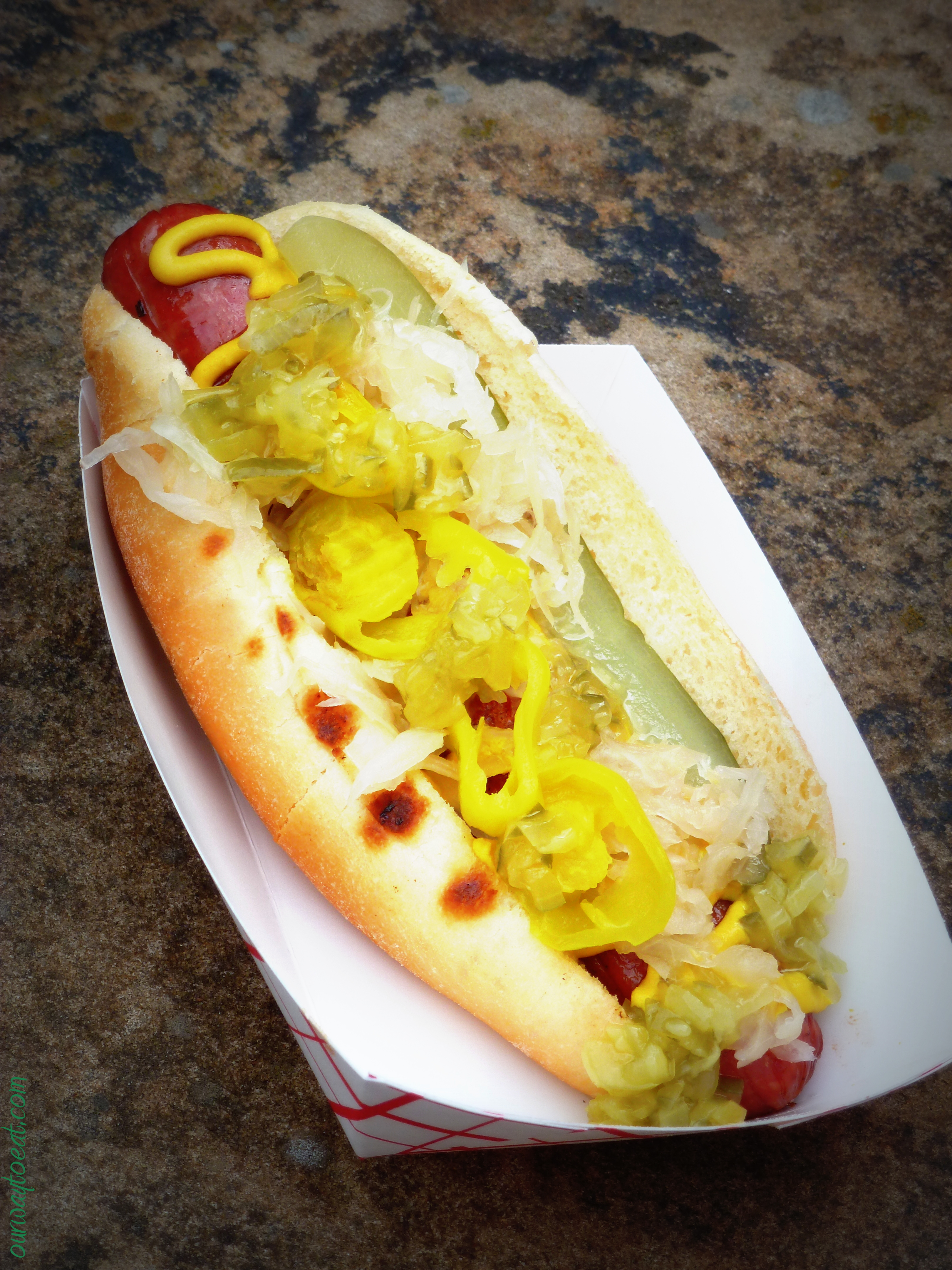 Our friend Jenny ordered a grass-fed, all-beef hotdog and also piled on the house-made condiments and garnishes. One of the Chef Shack chefs greeted us at the condiment table, and asked us cheerfully if we found what we needed. Yes, we certainly did. We walked away from the market, plopped down on a flat rock that served as our seating and table and enjoyed a wonderful, unique and tasty lunch.
Our friend Jenny ordered a grass-fed, all-beef hotdog and also piled on the house-made condiments and garnishes. One of the Chef Shack chefs greeted us at the condiment table, and asked us cheerfully if we found what we needed. Yes, we certainly did. We walked away from the market, plopped down on a flat rock that served as our seating and table and enjoyed a wonderful, unique and tasty lunch.
I’ve visited a handful of food trucks in Minneapolis and Saint Paul and this was by far the best food truck meal I’ve experienced to date. This is the sort of truck that justifies its existence. The food simple, inspired and is as good or better and more fresh than many restaurants, served casually, quickly and is perfect for outdoor eating on the go. If you find yourself in Minneapolis on a Saturday between the hours of 8 and 1, I highly recommend a trip to the Mill City Farmer’s Market followed by a delicious lunch from the Chef Shack. Delish!
Dijon and Herb-dressed Potato Salad for the Heart of Summer
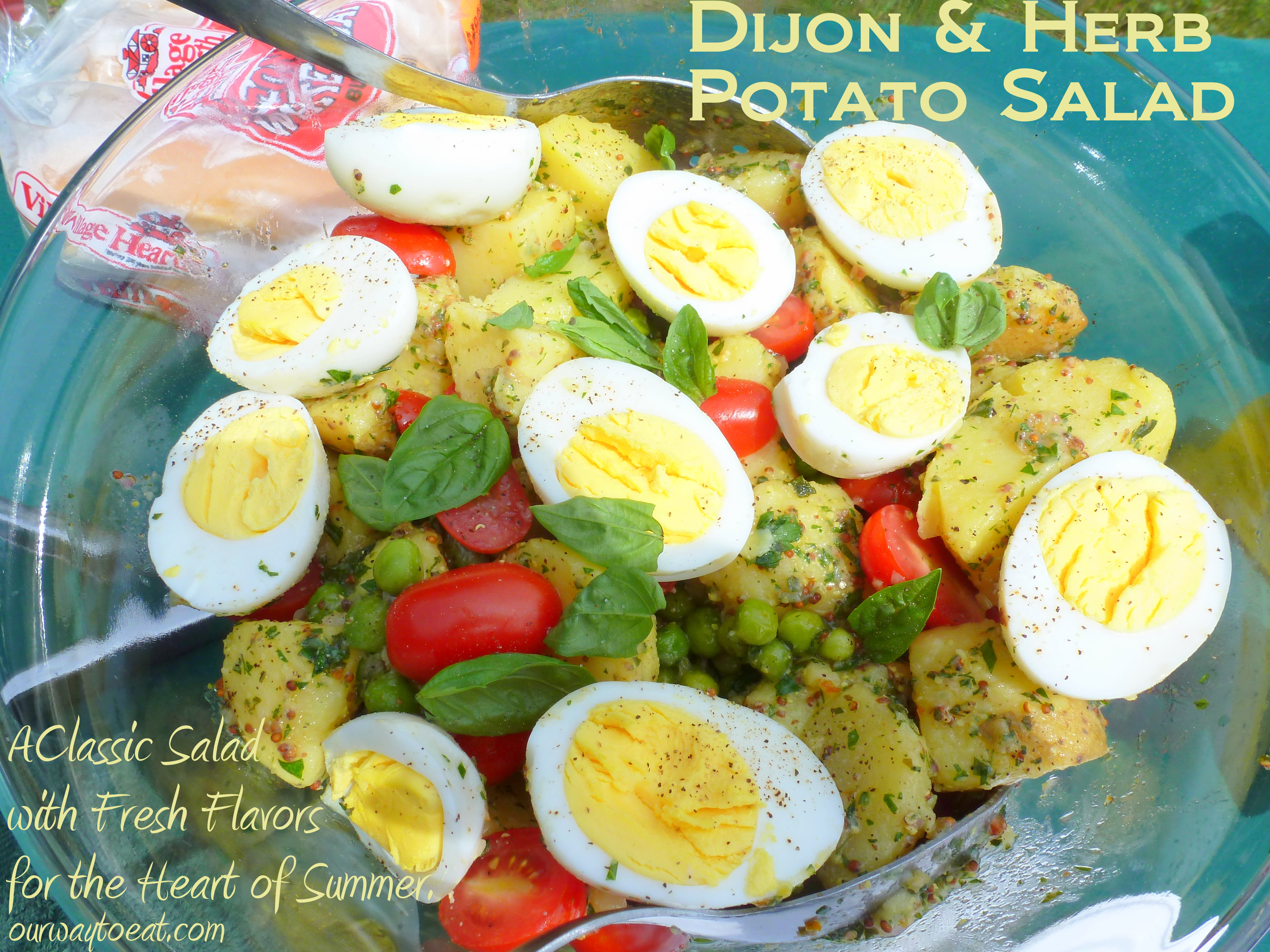 I love the heat, energy and fireworks explosion of people out enjoying life in every possible way that takes place in July; but to me, August is the heart of summer. I savor August days when the pace of life slows down, the garden booms and I can pause to soak in warmth, the natural wonders, brilliant flavors and the easy pace that life settles into at this time of year. I enjoy being able to base my seasons on what is happening outside, instead of on the school year or the sport’s calendar. It helps me keep the summer feeling alive to the last second when the fall chill genuinely takes hold. I understand that for many people, the first sign of a cooler evening, a fallen leaf or the school year looming close marks a change. Even so, it is too early to shift to autumn-cooking mode while the garden and farmer’s market is overflowing with beautiful summer vegetables and fruits. If you have a potluck, picnic or BBQ left on the agenda, trotting out the classic potato salad is probably starting to seem a little dull and repetitive. This is when it is time to turn the traditional potato salad on its heel–add some veggies to the ingredient list, subtract the typical mayo-based dressing. With a few tweaks, you have a bright, fresh twist on a classic potato salad that capitalizes on August abundance and tastes and looks so different, you will forget the creamy classic potato salad recipe you wore out in June and July.
I love the heat, energy and fireworks explosion of people out enjoying life in every possible way that takes place in July; but to me, August is the heart of summer. I savor August days when the pace of life slows down, the garden booms and I can pause to soak in warmth, the natural wonders, brilliant flavors and the easy pace that life settles into at this time of year. I enjoy being able to base my seasons on what is happening outside, instead of on the school year or the sport’s calendar. It helps me keep the summer feeling alive to the last second when the fall chill genuinely takes hold. I understand that for many people, the first sign of a cooler evening, a fallen leaf or the school year looming close marks a change. Even so, it is too early to shift to autumn-cooking mode while the garden and farmer’s market is overflowing with beautiful summer vegetables and fruits. If you have a potluck, picnic or BBQ left on the agenda, trotting out the classic potato salad is probably starting to seem a little dull and repetitive. This is when it is time to turn the traditional potato salad on its heel–add some veggies to the ingredient list, subtract the typical mayo-based dressing. With a few tweaks, you have a bright, fresh twist on a classic potato salad that capitalizes on August abundance and tastes and looks so different, you will forget the creamy classic potato salad recipe you wore out in June and July.
Dijon and Herb Potato Salad– Yield: 6 generous servings, 20 minutes hands-on, 50 minutes total time.
- 2 pounds small Yukon Gold or Red potatoes scrubbed
- 6 eggs, hard-boiled, peeled and halved or quartered
- 1 cup Fresh Peas or String Beans, or a combination of both
- 1 cup grape or cherry tomatoes, halved
- 2 tablespoons chicken or vegetable stock
- 3 tablespoons Tarragon vinegar
- 2 1/2 tablespoons Grainy Dijon mustard
- 8-10 tablespoons olive oil
- 1 minced shallot
- 2 tablespoons fresh dill, chopped
- 2 tablespoons flat-leaf parsley, chopped
- 2 tablespoons basil leaves, chopped, plus small, whole basil leaves for garnish
- salt and freshly ground black pepper
Method:
Drop the potatoes into a large pot of boiling, lightly salted water and cook for 20 to 30 minutes, until they are just cooked through. Drain the potatoes in a colander, then place them in a large bowl with the fresh peas or string beans on top and cover with a clean towel. This allows the beans or peas to steam along with the potatoes for 10 minutes more. Note, this approach worked for me, though if you are nervous about the peas or beans being cooked, add, them to the pot of boiling potatoes for the last few minutes, or steam them separately. Cut the potatoes in half or quarters if they are large. If you used Yukon Gold potatoes, you can slip off the skins right off at this point if you like. Toss the potatoes gently with chicken stock. Allow the liquid to soak into the warm potatoes before proceeding. 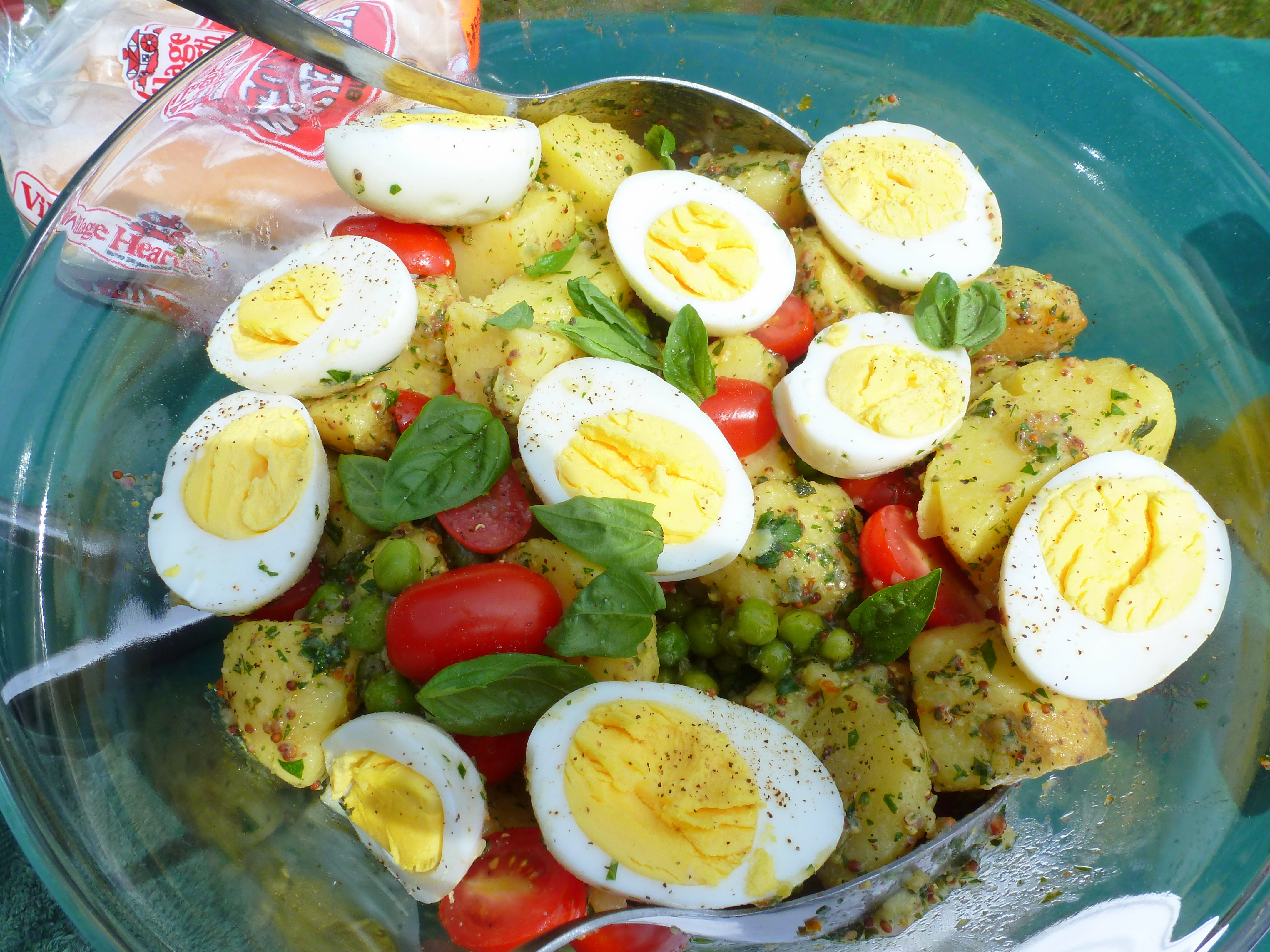
Combine the vinegar, mustard, olive oil with 1/2 teaspoon salt, and 1/4 teaspoon pepper in a small jar with a tight-fitting lid. Shake vigorously to make an emulsion. Add the vinaigrette to the potatoes. Add the shallot, dill, parsley, basil, salt and pepper and gently toss. Just before serving, toss in the halved tomatoes and top the salad with halved hard-boiled eggs, fresh cracked pepper and small basil leaves. Serve warm or at room temperature.
The Summer Sandwich // Simple Dining, Al Fresco
 This post is one part ode to one of my favor summer meals and one part cautionary tale. I figure that this blog is about my life, including some of the great meals in it, so I will start with a brief account the day when I spent inadvertently spent $17.72 on 0.57 lbs of cheese. [Oopsie.]
This post is one part ode to one of my favor summer meals and one part cautionary tale. I figure that this blog is about my life, including some of the great meals in it, so I will start with a brief account the day when I spent inadvertently spent $17.72 on 0.57 lbs of cheese. [Oopsie.] 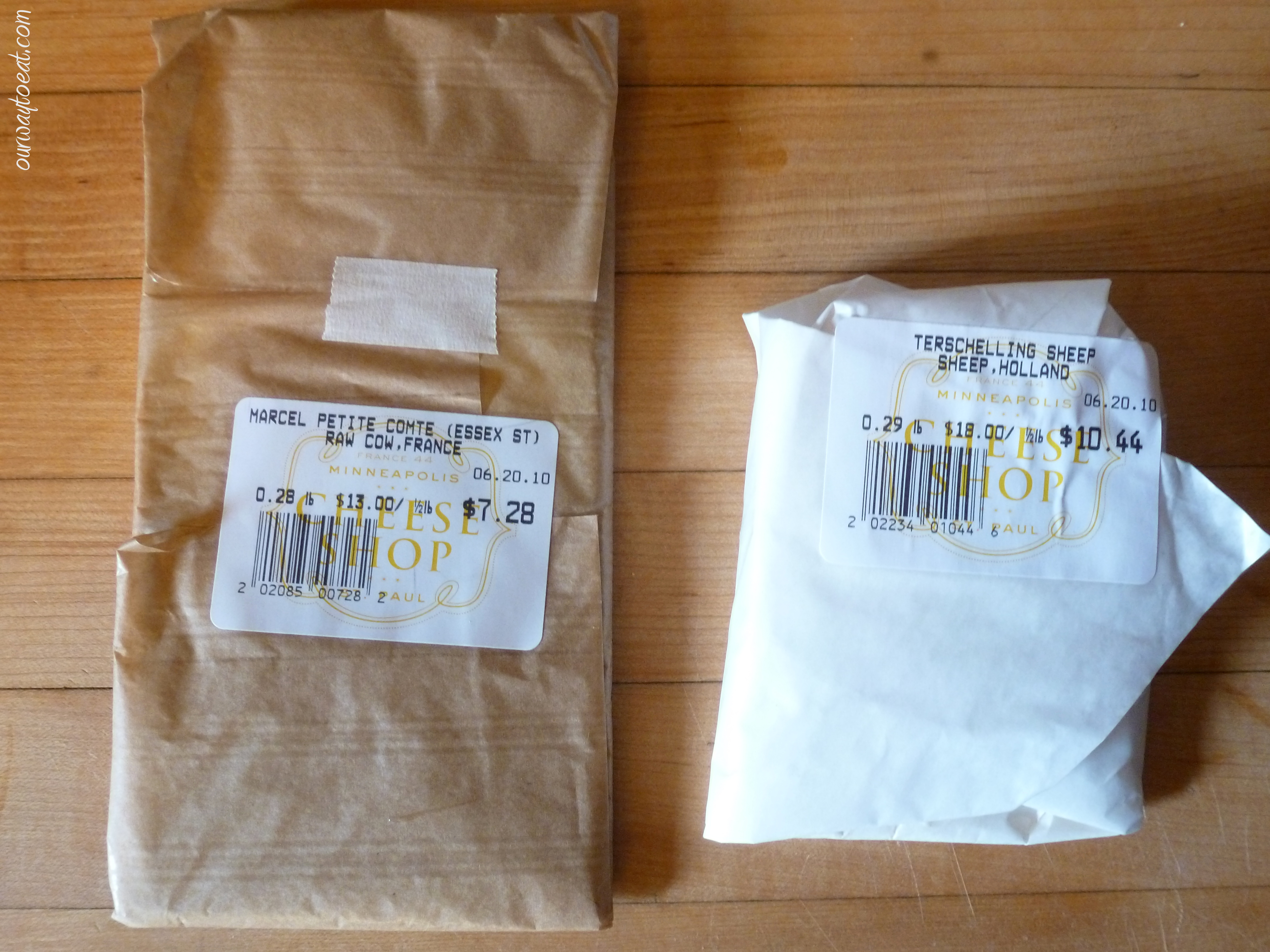
It was a typical Saturday morning. We started our day at the Saint Paul Farmer’s Market. I determined my mission that day was to purchase the components of a summer sandwich for our lunch. At the time, our garden still had a few weeks to go before it would have much to offer us. I bought vegetables, bread, and then we left the market and looped our way up Grand Avenue to the Saint Paul Cheese Shop. That place is pretty neat. Sampling is encouraged, so we tasted several paper-thin wisps of cheese the cheesemonger shaved neatly off of several wheels of cheese and dropped into our extended hands from the forked tip of the blade of his cheese knife. I let my guard down. It is atypical for me to make a mindless splurge without glancing at the price per half pound. I was in a cheese-induced stupor when I asked for a small wedge of Marcel Petite Comte raw cow’s milk cheese from France, and a wedge of Terchelling Sheep’s milk cheese from Holland. I’m sure there are people who routinely spend far more than this on cheese in any given week. I’m not knocking it and I might do it again at some point. The difference will be that I do it intentionally. As a consolation, at least the cheese was very, very good.
Whew. Now that I’ve made that confession to my friends and readers, let’s make a sandwich! A Summer Sandwich is quite simply a sandwich with any combination of meat or vegetarian meat substitute, seasonal vegetables, cheese and sandwich spreads piled on top of nice bread. 
I sliced a grainy loaf of bread and served the bread and cheese with our own cheese knives on wooden cutting boards. We eat most of our meals al fresco on our patio. It has been 90+ degrees farenheit there lately, but it is still very pleasant in the shade of a Maple Tree canopy.
I filled a platter with sliced cucumber and tomato, garden lettuces, piles of deli turkey and tofurky, along with bowls of mayonnaise and grainy dijon mustard, and placed salt and pepper shakers on the table. The secret to the perfect summer sandwich is bringing out whatever looks good and fresh, and let each person assemble the sandwich they desire. 
If Freud were here, he’d say, “a sandwich is never just a sandwich.” It is the meal I ate on pebble beaches out of a cooler with my parents camping in Door County, Wisconsin in grade four. It is the BLT’s that beckoned numerous cousins, Uncles and Aunts to my Grandma’s farm house every July when the tomatoes were all ripe at once. It is the meal of lettuce, ham, turkey, tomato and cheese sandwiches on good sandwich bread that we shared with friends from Edmonton, Winnipeg, Saint Paul and Minneapolis on a lakeshore in Northern Minnesota after a long, hot day on the lake last year over the 4th of July long weekend. It is the halved baguettes piled with cheese, sliced tomato and a pile of pršut [for the meat eaters] that we ate on a secluded pebble beach a few months ago in Croatia. 
What is one to serve on the side? Well, nothing—any decent summer sandwich is in itself, a square meal. Or, if the mood strikes, some salty-crunchy potato chips, leftover potato salad out of the fridge, deviled eggs or summer fruit would all be the perfect compliment. On this particular day we rounded out our plates with bright, rainbow radishes that were too pretty to slice or even to remove the stem. Sure, they could have been thinly sliced and piled on the sandwich, but they were refreshing, spicy perfection and a visual treat perched on the side our plates. 
A Summer Sandwich is simple perfection. No matter what fresh fixings are available, where you are, or what time it is, a sandwich satisfies hunger. A sandwich feeds a crowd with varied tastes, comes together easily and is a perfect meal to eat outdoors on a hot July day. 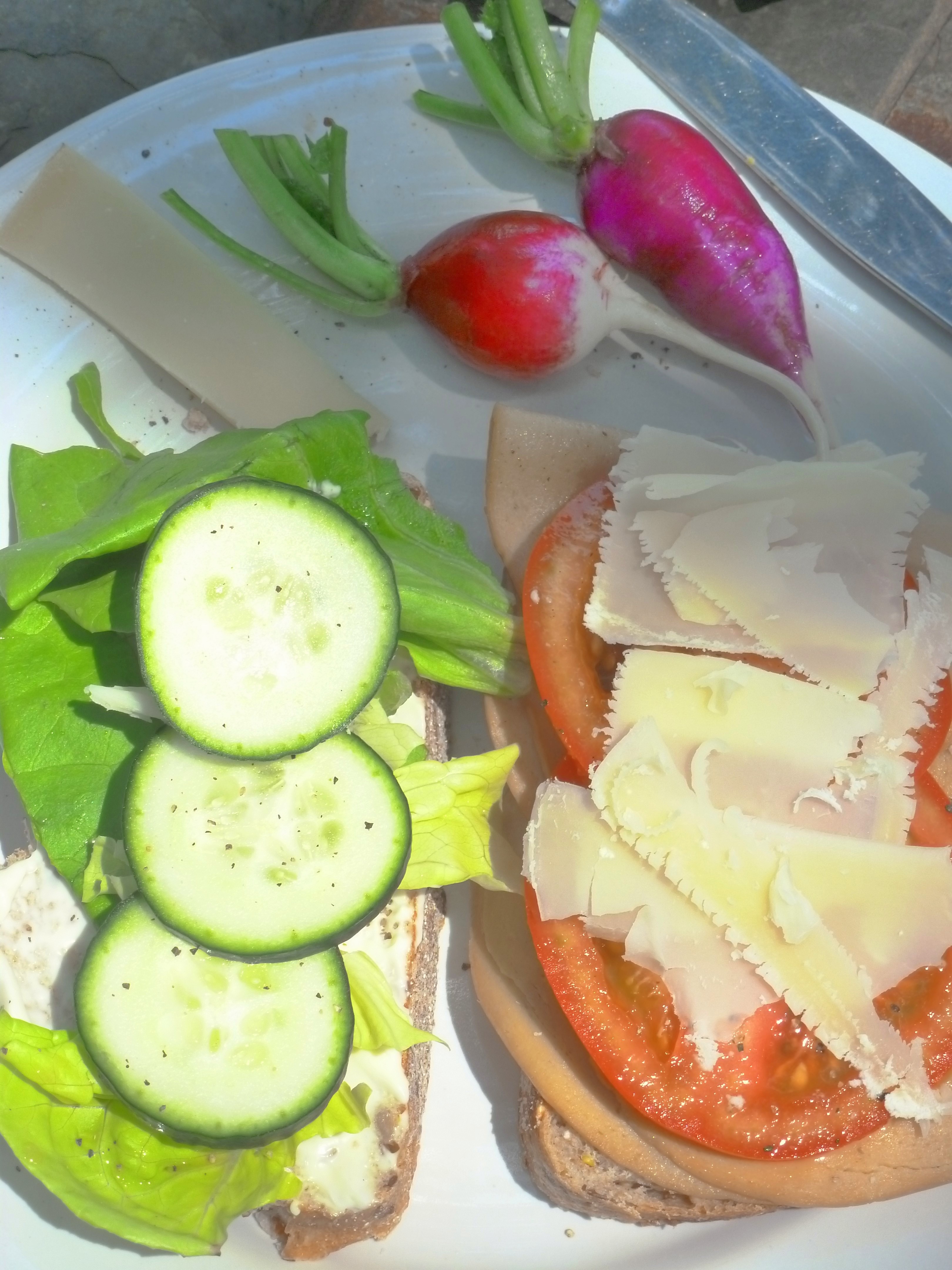
And the cheese?
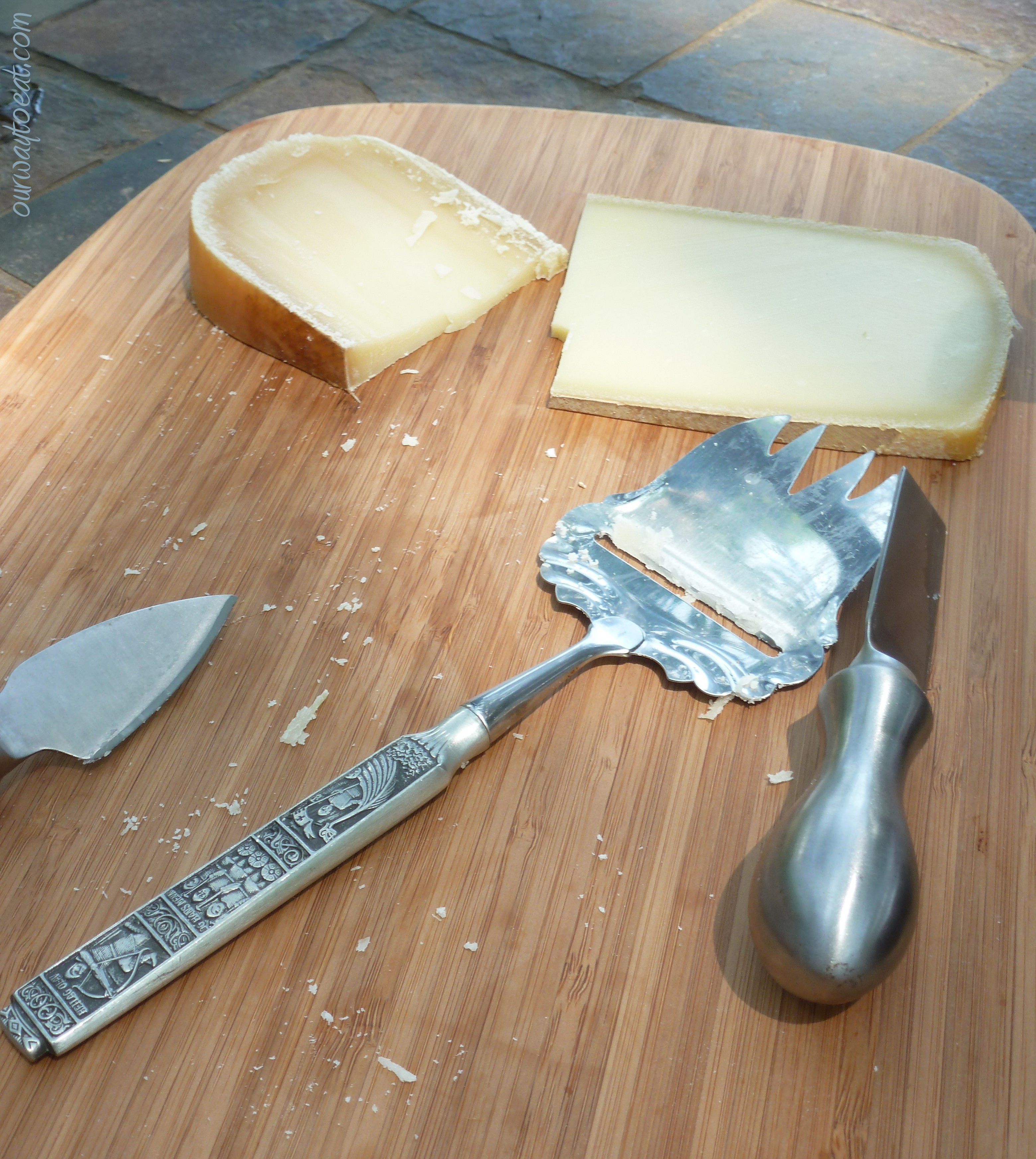 We’re still working our way through it, and savoring every little morsel–we figure it cost us about 8 cents per crumb.
We’re still working our way through it, and savoring every little morsel–we figure it cost us about 8 cents per crumb.
Remembrance and Red Currants
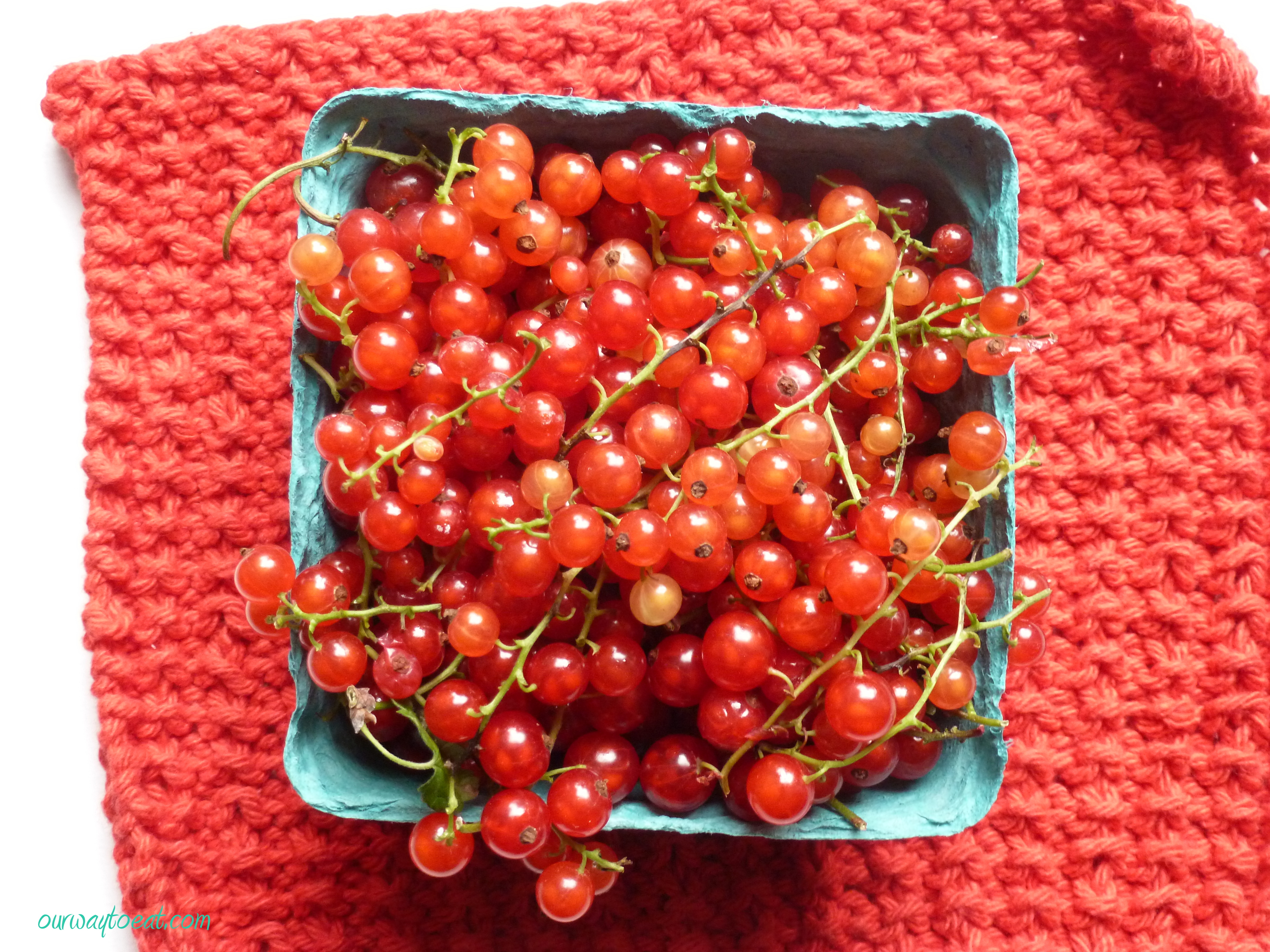 In my childhood, summers stretched long and leisurely. The two places you’d find me were at our cottage on the lake or my Grandma’s farm-house, a mile away from our cottage through the woods and across the field. My Grandma had a currant bush. Each July, one or more of us cousins, Uncles and Aunts were handed an aluminum bowl with a dented silver bottom, and a low wooden stool to sit on, and sent out to pick the currants. That task, and that shiny, dented bowl passed as a torch of honour among us. There always seemed to be enough currants for several of us to have our day to help pick the seemingly endless supply of brilliant, red berries, and later, be given more than our fair share of praise for the resulting pies.
In my childhood, summers stretched long and leisurely. The two places you’d find me were at our cottage on the lake or my Grandma’s farm-house, a mile away from our cottage through the woods and across the field. My Grandma had a currant bush. Each July, one or more of us cousins, Uncles and Aunts were handed an aluminum bowl with a dented silver bottom, and a low wooden stool to sit on, and sent out to pick the currants. That task, and that shiny, dented bowl passed as a torch of honour among us. There always seemed to be enough currants for several of us to have our day to help pick the seemingly endless supply of brilliant, red berries, and later, be given more than our fair share of praise for the resulting pies.  When I picked the currants in Grandma’s yard they reminded me of beads, dangling from intricate jewelry–abundant, glowing, red orbs, suspended from a wire-thin stem, and secured with a tiny knot. I ate many of the shining rubies right off of the bush. My Grandma lovingly folded those that made it into the house between crusts into a pie, baked in a much-used tin pie pan, and served it warm with a generous scoop of vanilla ice cream for dessert.
When I picked the currants in Grandma’s yard they reminded me of beads, dangling from intricate jewelry–abundant, glowing, red orbs, suspended from a wire-thin stem, and secured with a tiny knot. I ate many of the shining rubies right off of the bush. My Grandma lovingly folded those that made it into the house between crusts into a pie, baked in a much-used tin pie pan, and served it warm with a generous scoop of vanilla ice cream for dessert.  The tart-sweetness of the berries under tender crust lingers in memory, inseparable from the warmth of summer days with Grandma. A few weeks ago at the Farmer’s Market I came upon an older Tasha Tudor-like lady who wore her long hair wrapped around her head in braid. She had 4 or 5 little berry boxes filled with Red Lake Currants sitting out at her stand. When I bought them, she told me that she likes to eat currants on yogurt for breakfast, or in salads. She also told me they’d be good for a few weeks. I felt a gentle touch of my Grandma’s spirit tasting those tart currants and talking to the sweet elderly lady.
The tart-sweetness of the berries under tender crust lingers in memory, inseparable from the warmth of summer days with Grandma. A few weeks ago at the Farmer’s Market I came upon an older Tasha Tudor-like lady who wore her long hair wrapped around her head in braid. She had 4 or 5 little berry boxes filled with Red Lake Currants sitting out at her stand. When I bought them, she told me that she likes to eat currants on yogurt for breakfast, or in salads. She also told me they’d be good for a few weeks. I felt a gentle touch of my Grandma’s spirit tasting those tart currants and talking to the sweet elderly lady.  I couldn’t bring myself to add the currants to yogurt or salad. This early-July treasure must be made into a dessert. I couldn’t think of anything I could make that would do the currants justice–I am not much of a baker. I put the currants in a bowl and carried them with me up north to the lake last weekend. I left the bowl of currants with my mother. She knows the tart-sweetness of the pie in my memory and will adeptly fold them between crusts and savor the lingering warmth of July days past.
I couldn’t bring myself to add the currants to yogurt or salad. This early-July treasure must be made into a dessert. I couldn’t think of anything I could make that would do the currants justice–I am not much of a baker. I put the currants in a bowl and carried them with me up north to the lake last weekend. I left the bowl of currants with my mother. She knows the tart-sweetness of the pie in my memory and will adeptly fold them between crusts and savor the lingering warmth of July days past.
Cheeseburger Salad and Deviled Eggs with Dill
Summertime is a season and a mindset for me. It is a season to avoid being booked and busy as much as possible, to allow time to be free to savor summer’s simple pleasures. Over the weekend, this included a trip to the Saint Paul Farmer’s Market, a meal outside on the patio at a favorite restaurant, picking a few weeds in the garden, inviting my cousin over to hang out in our back yard, working up a sweat doing yard cleanup, going to the pool for a swim and sitting in the sun porch listening to rumbling thunder and watching rain pour down, giving our garden a thorough soaking.
The summer mindset is also reflected in the food we eat. We like to eat outdoors in our back yard on the patio as much as possible. The availability of a great variety of fresh produce at the market and from our garden shapes our menu. We make frequent use of the grill. Grilling has the multiple benefits of allowing us to cook outside on the patio, avoid heating up the house and further influences our food choices toward simple, classic summer fare.
One classic summer food staple that I’m thrilled to see back in vogue are deviled eggs. Why wouldn’t these re-emerge and get trendy? They are perfect, tasty bites, extremely simple and they can be made with all kinds of interesting ingredients. I’ve seen deviled eggs with crab meat, bacon, capers and even caviar-topped deviled eggs on food blogs and restaurant menus. I like a classic deviled egg the most, and I don’t follow a recipe. I boil, cool and peel the eggs, mash the yolks and mix in minced onion, a little grainy Dijon mustard and just enough light mayo to make them creamy. I attempted to pipe the filling back into the egg white halves from a pastry bag, but I chose too small a tip to allow the filling’s grainy mustard to squeeze through, so the piping experience started out with a few pretty, piped deviled eggs, then an explosion, followed by me filling the rest of the eggs with a teaspoon. Garnish is a must, especially with the teaspoon egg filling-method. In the off-season, I’m still a fan of a sprinkling of paprika, but in the summer, chopped chives or dill are my go-to garnish. I call the dill from our garden “Electric Dill” because it is so bright and fragrant, and the dill flavor just pops- electric!
Today was one of those days that I was half-way between two dinner ideas. Bjorn had thawed some lean ground beef raised by his uncle, and I had a hankering for a veggie burger with all of my favorite burger toppings, but also a salad. From what I’ve been reading, it is better not to eat bread and high-glycemic, addictive [delicious] carbs at every meal. The idea of a Cheeseburger Salad was born. I am sure I’m not the first to think of it. Mine ended up somewhere in the realm of California Burger meets Mushroom and Swiss, but the topping possibilities are only limited by your imagination–avocado, fried egg, pickles, sauerkraut and crispy bacon all come to mind. The basic premise is to deconstruct your favorite burger, up the veggie count, leave out the bun, and have yourself a great salad. 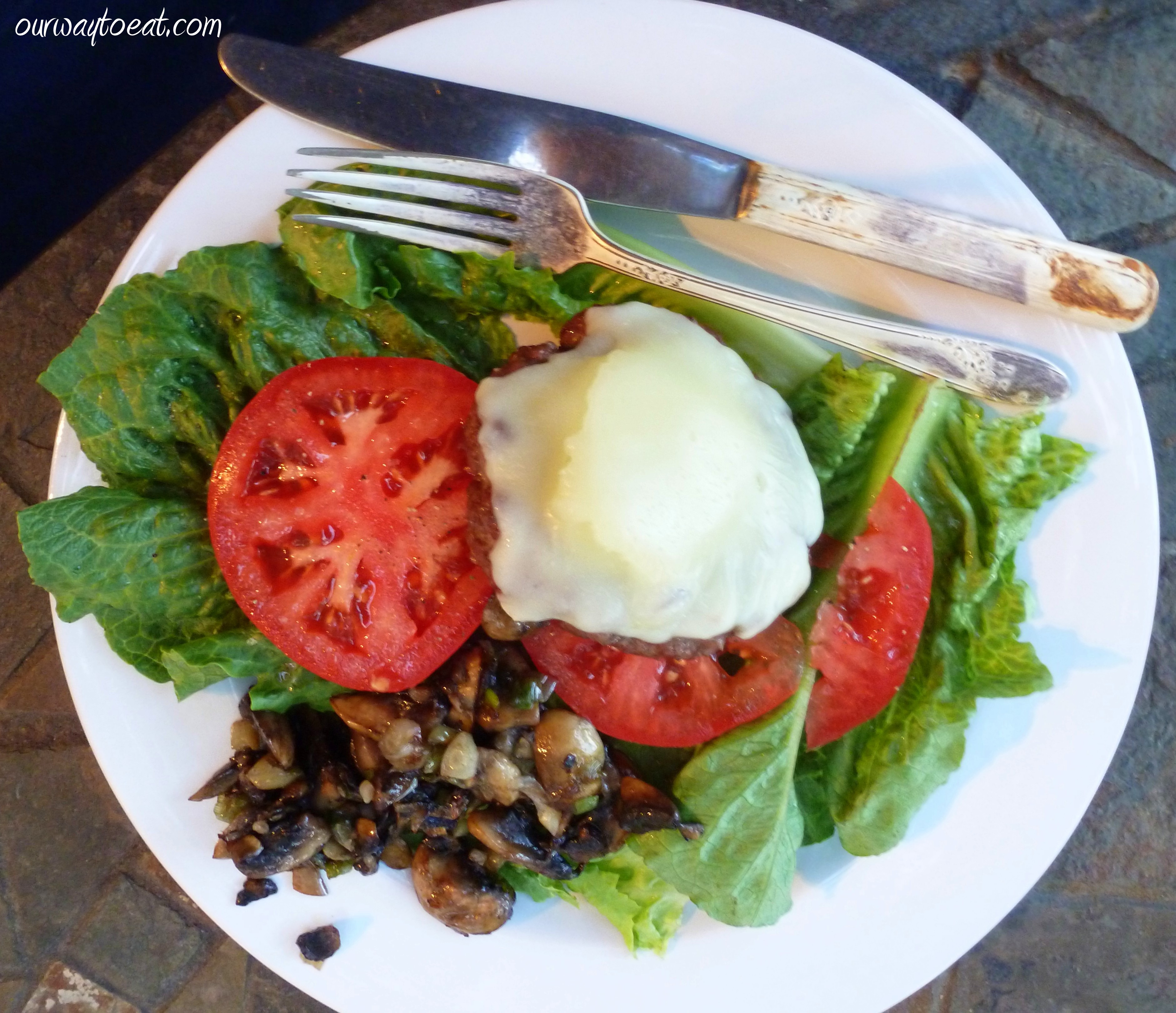
Bjorn grilled up a burger for himself, and a veggie burger patty for me, and topped both with thinly sliced provolone cheese. We sautéed mushrooms with some onions on the grill’s side burner, and served the burgers and sautéed mushrooms and onions on a bed of lettuce leaves with sliced tomato from the market. As a dressing, we used a little leftover creamy taco sauce that I mixed up for another meal which consisted of smoky chipotle and garlic salsa mixed with a little light sour cream.
We rounded out the meal with a few bright red radishes from the farmer’s market. We are both obsessed with farmer’s market radishes at the moment. They are brighter and spicy, and of no comparison to most radishes I’ve tasted from the grocery store. I’ve been keeping a bowl in water in the fridge so that they are ready for snacking and ready to be served at any meal, including breakfast! I cannot wait until radishes from our garden are ready to eat.
I’m sure I’ll make Cheeseburger Salads again, and will certainly make more deviled eggs. Even with the richness of a deviled egg, and melted provolone, the meal felt just little lighter. After the deviled egg filling vs. piping bag incident was cleaned up, the meal came together quickly, giving us time to sit back and watch the cardinals hanging out in the grass.
A Vibrant Quinoa Salad for a Dark Winter’s Day
Some days there is nothing more refreshing and satisfying than having a hearty salad as a meal. A salad can be extremely handy too, when it is built to last so that it can reappear the next day as our lunch. That is the sort of meal I had in mind today. The salad I made was loosely based on a recipe for a Wheatberry Salad that I read about on Macheesmo, a blog I like to visit. I’ve been trying to follow more recipes because I want well-developed flavors and predictable results when I cook. Even though I’m trying to follow recipes, I still have to strike a balance. I am not one to plan meals in advance, and I don’t like to run to the store when I decide to make something. I began by gathering ingredients.
In my salad, I subbed Quinoa for Wheatberry. I’ve glanced at a bag of Wheatberry in the grocery store, but haven’t purchased that grain so far. I am still working on integrating Quinoa into my regular cooking routine. I also subbed fresh spinach for kale, and half a block of drained and crumbled tofu for feta cheese. We’ve been working our way through a bag of organic parsnips from the Farmer’s Market that we bought at Thanksgiving, so I decided to add a few. I started cooking 1 1/2 cup of quinoa in an equal amount of water, and while the quinoa cooked, I chopped the vegetables into small, uniform chunks. They say you eat with your eyes first; the vibrant rainbow of crunchy vegetables chopped for this salad was a visual feast.
The salad is dressed with the juice of a lemon, the lemon’s zest, red pepper flakes, salt and pepper. It gives the salad a lot of kick with zero added fat. Healthy!! The lemon juice has the added benefit of keeping the avocado from turning brown. If I make this again, I will cut back on the lemon zest a little bit. The zest of a lemon is pretty punchy, especially when you eliminate a creamy dairy component which was included in the original recipe.
 Did we notice the substitutions I made to the original recipe? A little. Crumbled tofu has a similar texture to feta cheese, but it lacks the tang. There is also a certain creaminess that feta would add, which would also probably help balance the pungent citrus in the salad. Neither of us are huge fans of feta, and so it was a fair swap to make, and healthy too. I am all for subbing spinach for the kale called for in the original recipe. I have yet to delve into kale, and I love how easy it is to add a big bunch of fresh spinach to almost anything you are cooking and allow it to steam in just a few minutes. We both enjoyed the salad with a dash of Habenero Chili hot sauce that we brought back from Mexico.
Did we notice the substitutions I made to the original recipe? A little. Crumbled tofu has a similar texture to feta cheese, but it lacks the tang. There is also a certain creaminess that feta would add, which would also probably help balance the pungent citrus in the salad. Neither of us are huge fans of feta, and so it was a fair swap to make, and healthy too. I am all for subbing spinach for the kale called for in the original recipe. I have yet to delve into kale, and I love how easy it is to add a big bunch of fresh spinach to almost anything you are cooking and allow it to steam in just a few minutes. We both enjoyed the salad with a dash of Habenero Chili hot sauce that we brought back from Mexico.
This salad was a success for several reasons. It contained an antioxidant rainbow of healthy vegetables. It also contained the healthy fat found in avocado. The texture was the best part of the salad; it had crunchy carrots, celery, onions, parsnips, peppers which balanced well with the creamy avocado, supple quinoa, tofu and tender steamed spinach. There was plenty of kicky flavour without any regret with the spicy-citrus dressing. It was also a win from a vegetarian-protein perspective since it contained both tofu and chickpeas. All in all, it was a light, uplifting, healthy and hearty entrée salad that hit all of the important notes that it needed to pick us up on a grey day in January. Yes!!
Bjorn said the salad was tastier than he expected, and we both ate it again the next day. For me, it was both breakfast and lunch. I need to make a crunchy, kicky, creamy, low-fat, high flavor, protein-rich salad more often.
Saving Summer
I often mention the Saint Paul Farmer’s Market. It has become a destination for us every weekend. We have a garden of our own, and so we have a daily supply of tomatoes, lettuces, peppers and many herbs throughout the summer and into the fall. Still, there are so many summer and autumn vegetables we don’t grow that we pick up in our weekly excursions to the Saint Paul Farmer’s Market. It is our source for corn, leeks, squash, melons, green onions, garlic and new species of vegetables to try for the first time. I had aspired to start canning this year, but by the time I had a free weekend, I was a week too late to do pickles, and just not as excited to make the effort for canning Dilly Beans. Salsa or pasta sauce would be fun, but I didn’t want to worry about pH levels in my first canning project. Pickled items just seem like a safer place to start. So, I gave up on the idea of preserving summer produce for winter. Then, as the summer wore on, I noticed that prices started to drop on large quantities of produce from $18 to $16 to $10 for a huge box and I couldn’t resist. I bought a crate of local tomatoes*, and planned to preserve them in the easiest way I know: blanche, chop and freeze them without seasoning to be used in sauces, chili and soups. I bought the crate of tomatoes on a late summer Saturday. My parents were visiting, so I didn’t get around to starting the blanching and freezing project until Tuesday evening.
I set up my blanching station on my handy kitchen table.** My essential list of tools included quart size freezer bags, 2 very clean plastic dish pans, one to be used for rinsing, and one for the ice water bath; 2 colanders; 2 cutting boards; a sharp paring knife; a bamboo-handled wire strainer (not pictured) and a large amount of ice for the ice water bath.
To begin, I washed the tomatoes and placed them in water in a plastic dish pan. I cleaned them up as needed with the paring knife, and cut a small X in the bottom of each clean tomato. When I had a colander full of cleaned up, scored-bottom tomatoes, I put them in a pot of boiling water on the stove, and left them there for 30 seconds. I initially set up two pots of boiling water on the stove, but soon realized that one pan of boiling tomatoes was all that could be tackled at a time with my small operation and two hands.
I removed the tomatoes from the boiling water with a wire scoop, and put them directly into the ice water bath. The hot to cold transition made the skins easy to slip off. I let them soak in the bath until they were cool enough to handle, removed the skins by hand and core quickly with a knife. I thought that cores came out more easily after the tomatoes were blanched.
Since most sauces are better with more of a tomato’s flesh than its liquid and seeds, I chopped the tomatoes and removed most of the seeds, and let the chopped tomatoes drain for a minute over the sink in a second colander so that my frozen tomatoes would be less liquid-y when thawed. The last step was to scoop the drained, chopped tomatoes into a quart-size freezer bag, and to remove as much of the air as possible before sealing the bag. Each colander-full batch of raw tomatoes yields a quart-size freezer bag filled about ¾ full. In total, I repeated this process for more than 2 hours and ended up with 9 quart freezer bags of tomatoes. It was some work, but 9 quarts of locally grown tomatoes frozen at the peak of freshness for $10 is a pretty good deal for the enjoyable effort that is involved.
 Toward the end of the project, I got exhausted and I had to call in backup. Bjorn jumped right in and helped me see the project through to its close. I think it was the first time I’ve ever gotten wrinkled fingers from cutting up vegetables. Even though my Tuesday evening turned into a tomato-y marathon, the process of putting up food for the winter was rewarding. I’m certain that we’ll savor our favorite summer flavor preserved for the cold months to come.
Toward the end of the project, I got exhausted and I had to call in backup. Bjorn jumped right in and helped me see the project through to its close. I think it was the first time I’ve ever gotten wrinkled fingers from cutting up vegetables. Even though my Tuesday evening turned into a tomato-y marathon, the process of putting up food for the winter was rewarding. I’m certain that we’ll savor our favorite summer flavor preserved for the cold months to come.
*N.B., readers and self: this quantity is plenty for one person to handle in one evening.
**My kitchen table is a vintage enamel-topped table that I bought about 9 years ago. Through law school it served as a computer desk and work station. Last year we moved it into the kitchen for Thanksgiving preparations and discovered how nice it was to have some additional workspace in our tiny kitchen. I painted the table base flat black and Bjorn added casters. We use it constantly for cooking and baking projects, painting, sorting mail, as a place to sit for breakfast or have a guest sit while we cook a meal for them. I just love it.


